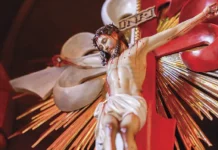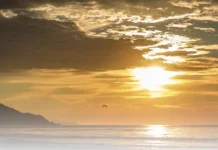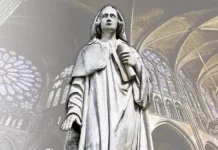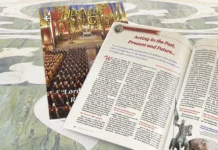A man reduced to only half of his natural movement left an unforgettable lesson for history, defeating the “invincible” English naval forces in Cartagena de Indias.
T he Mediterranean Sea serenely watched the approach of another storm. It was the dawn of August 24, 1704 and two imposing armadas faced one another near Gibraltar, on the southern coast of Andalusia. On one side, the English and the Dutch formed a formidable fleet “consisting of sixty ships of the line and several frigates, with a total of three thousand six hundred cannons and almost twenty-three thousand men.”1 On the other side, setting out to conquer the strait, the French and Spanish united their banners under the orders of Louis Alexandre de Bourbon, Count of Toulouse and son of Louis XIV himself, and battling on behalf of His Majesty Philip V, grandson of the Sun-King, who had recently ascended to the throne of Spain. It was the beginning of the War of Spanish Succession.
The forces were evenly matched. At ten o’clock in the morning the last orders sounded, the ships manoeuvred and arranged themselves, on both sides, in three blocks, in order to bar the advance of the enemy.
On the French-Spanish flagship, a young fifteen-year-old officer was inspecting a line of cannons. A cold sweat stood on his forehead, but with a firm step, a serious countenance and a decided voice, he inspired respect and maintained his authority, while inside himself he repressed a rebellious fear. The intense silence that precedes great calamities announced the final seconds before the general deflagration, and it gripped his heart. He felt the emotions of the baptism of fire; it was his first battle.
The muffled and grave roar of the first cannons shots could be heard in the distance. This was soon followed by flames, tremors, smoke and destruction. Cannon balls were flying, the sides of the ship were shaking, and with them the men. The voice of command could only be heard with difficulty: “Fire!”

Where was the young officer? A ruthless ball of lead had carried away half his left leg. He was rushed to the “operating room” – a euphemism for the terrible, poorly lit amputation table which, below sea level, accommodated the wounded in battle. It dripped with blood. All the surgeon’s skill was measured against a stopwatch, because the longer it took, the greater the danger of the patient not being able to withstand the bleeding or contracting an infection.
They placed the young man on the operating table. A good portion of brandy was poured down his throat; then a leather band placed between his teeth – that was the anaesthetic.
The operation began by extracting the last pieces of flesh that were still hanging below the knee. Then, with a saw, the tibia and fibula were trimmed. Finally, the stump was submerged in boiling pitch to staunch the haemorrhage. All this in less than a minute.
The boy endured these horrors with exemplary bravery, the echo of which reached the ears of Louis XIV. Astonished, the French king awarded him the title of Alférez de Vajel de Alto Bordo, to which Philip V added other honours.
This young hero from the modest aristocracy of Pasajes de San Pedro in the northern Spanish province of Guipúzcoa, was called Blas de Lezo y Olavarrieta.
Life at sea
How would a fifteen-year-old react after such a misfortune? Surely he would suffer an irreversible trauma and abandon the career that he had hardly had the opportunity to begin.
But this was not the 21st century. Blas de Lezo was already contemplating many other adventures. If his life dated back to medieval times, modern man would reckon it among the legends; however, as he was born in February 1689,2 we can list him among the heroes and accurately narrate here his fascinating story.
Blas learned to move around nimbly on a very awkward wooden leg, which soon earned him his first nickname: “anka-motz” in the Basque language or, in Spanish, “pata-palo,”3 peg-leg. After being trained to walk and even to ride horseback with it, he was admitted back on board.
His name reappears in history during a mission to defend the city of Peñíscola, where he took part in the burning of an English ship with sixty cannons. In August 1705, he was summoned to the aid that the Franco-Spanish navy would render to the city of Barcelona, besieged by the opponents of Philip V. There we see him at the helm of a small vessel, surrounded by English ships. The daring officer ordered the use of “red bullets”, lead balls heated in the ship’s furnace. He set fire to an enemy ship and escaped the siege amid clouds of smoke.
Thirsting for feats beyond mere duty, Don Blas de Lezo was assigned as a ship’s lieutenant, at the age of only eighteen, in defence of the Fort of Santa Catalina in Tólon, from which he spotted a powerful English fleet approaching. Providence seemed to be testing the courage of the lame young man, who this time had the misfortune of losing his left eye. But he also survived this dangerous injury, which could have cost him his life.
Did he abandon a career so exposed to what some would call “unwarranted” risks? No. In 1714, he was at the helm of the seventy-cannon ship Nuestra Señora de Begoña, also known as Campanela, with which he took part in the bombardment of the city of Barcelona during the civil war raging in Spain. In one of those raids, Blas lost the movement of his right forearm, as bones and tendons were destroyed.
That “mediohombre [half-a-man]”, pursued and so often grazed by death, nevertheless did not consider himself sufficiently incapacitated to be excused, in conscience, from duty and adventure.

On February 3, 1737, he set sail on a new mission, in command of a convoy with two main ships: Conquistador and Fuerte. His destination: America. For the second time, Blas was crossing the Atlantic. Such voyages were far from easy ones, but at that time they provided long periods of silence and reflection. In this enormous and harmonious cloister called the sea, how many premonitions must that analytical captain not have felt? The greatest challenge of his life awaited him on the other side of the ocean.
Cartagena de Indias
On March 11, Blas set foot on dry land. At a glance, he took in the formidable Bay of Cartagena and the sorry state of the fortifications. There was no time to lose. This city, the key point of Spanish colonization in Latin America, had been the target of a series attacks and threats.4 And the forecasts for the future were not encouraging. A Spanish spy, known by the nickname of El paisano, had obtained very reliable and precise information in Jamaica that the English intended to overthrow Spanish trade and dominion, with Cartagena de Indias as one of their main targets.

Guendulain Palace, Navarra (Spain)
Raising the spirits of an indolent garrison, Blas reinforced the city’s defence. He worked “not as if he were a commander, but as the least of the cabin boys,”5 serving as a model and an encouragement to everyone.
The commander of the fleet’s plans for to repair and expansion were well underway when the arrival of the viceroy of New Granada, Don Sebastián de Eslava y Lasaga, was announced. A learned and experienced military man, full of conceit for his great reputation at court, he seemed almost the antithesis of Blas de Lezo, who could hardly hide his disappointment on hearing his first words. He watched the viceroy complain about the voyage and moan about his aches and pains, while an astonished crew quietly unloaded the ship. One hundred and fifty bodies had been thrown overboard along the way, victims of starvation and scurvy.
It had indeed been a terrible voyage. But a sailor like Blas – for whom hunger, scurvy and enemy fire were nothing new, and the privations of long voyages meant nothing more than the duties of the trade – could not muster any sympathy for a commander who assumed his position amid whining and lamentations…
Blas, however, went ahead and informed Eslava of the state of the defences of Cartagena, and, above all, conveyed to him the latest news of the English advance. “It is nothing! If anything happens, their objective will surely be Havana and not Cartagena,” replied the viceroy.
Until the very end, Eslava would be from the school of obstinate optimists. Regarding the work done by Blas de Lezo, he did no more than note deficiencies – well observed, in fact – with a friendly smile.
First threats
On March 13, 1740, a small English squadron appeared on the horizon and opened fire to draw the defenders out of their positions and show their strength. But Edward Vernon, commander of the English fleet, knew that it was not yet the opportune moment for the assault. He was waiting for reinforcements and merely wanted to reconnoitre the city. During this waiting period he entrusted his men with other missions in the vicinity, so that the echo of small conquests would resound loudly in the British Parliament to the honour of his name.
The fleet then returned to Jamaica for the last preparations before the attack on Cartagena de Indias. There it received considerable reinforcements, bringing it to “a total of more than one hundred and seventy ships and thirty thousand men.”6
Meanwhile, repairs and additions to the fortifications of Cartagena continued. Wooden bastions were erected, walls extended and the enormous iron chain that prevented entry to the bay was inspected. Eslava, who “was not yet fully convinced of the eventuality of the English attack,” completed the work that Don Blas de Lezo been carrying out for years but “even so, without acknowledging his efforts.”7

National Portrait Gallery, London
The Spanish, for their part, had received no major reinforcements. They possessed only six warships, with four hundred and sixty pieces of artillery.
The English assault begins
The probable storm became reality: on March 13, 1741, the sails of nearly one hundred and eighty vessels billowed on the horizon.
The English fleet approached and hemmed in the entire coast right up to just south of the city. Along the way it opened fire on the walls, destroying the batteries of Chamba, San Felipe and Santiago.
Blas de Lezo was in the Fortress of San Luis de Bocachica, an important edifice that defended the entrance to the bay to the south. From there he asked Eslava for three hundred men. The latter grudgingly sent him one hundred and fifty, ordering them to return to the city on the following day…
On March 20 the most feared possibility materialized: the English initiated a landing to assault the Fortress of San Luis, incomparably more vulnerable by land. With a large contingent of Jamaican natives – about a thousand of them – they began to set up a first camp and a battery.
As they continued their land advance, Vernon ordered his forces to bombard the fortress. They were often driven back by artillery from the ramparts and the battery of San José, which was also steadily firing from behind the opening called the Bocachica. In one day this battery was rendered completely useless. However, to the amazement of the invaders, it opened fire again on the next day, for it had been rebuilt during the night under the orders of the indefatigable Blas, using earth and remnant ship parts!
At a quarter past seven on the morning of April 2, 1741, the Spanish had a great surprise. The trees in the direction of Tierrabomba disappeared in an instant, and the astonishing scene of twenty twenty-four-pounder cannons and forty mortars was unveiled. Blas, weeks before, had insisted with Eslava that all the trees on the island be cut down, in order to avoid this type of ambush… However, as on so many other occasions, his advice had fallen on deaf ears.
Eslava then convened a council of war on the flagship Galicia. During the heated debate among the officers, a cannonball carried away the very table on which they were working, wiping out everything in its path. Eslava was slightly wounded, but Blas de Lezo added a few more decorations to his body already so honoured by enemy fire: he had one of his hands and a thigh badly injured by shrapnel.
In his diary, in which he makes very little mention of his deeds and is even more laconic about his pain, he only notes: “At nine in the morning I was wounded in a thigh and a hand.”8
He refused to be evacuated and continued to debate with Carlos Desnaux on how best to abandon his position in San Luis.
Before long the English had conquered the entrance to the bay, reaching the last line of defence of the Spanish. The latter were abandoning and destroying fortresses which, according to Eslava’s opinion, were untenable positions. Blas, not without reason, was indignant, as he wanted to make the enemy pay dearly for every position that they had to abandon.
To add to the altercations between the two commanders, Eslava ordered the sinking of the last two ships that remained, to obstruct the passage of the English, which was of no use at all. However, even though he foresaw these disasters and sometimes let a few barbs slip from his pent-up anger, Blas maintained intact his obedience to the legitimately constituted authority.
Unexpected victory
In the meantime, Vernon was already singing victory. He sent the frigate Spence, commanded by Captain Lowes, to England with news of the imminent capture of Cartagena. There, “imminent” was interpreted as “indisputable”. The cannons of the Tower of London roared, the belfries sounded and commemorative coins were distributed, on which Blas de Lezo – with two legs… – was depicted kneeling before the British commander. On the back of the coin read the inscription: “The pride of Spain humbled by Admiral Vernon.”
On April 20, 1741, however, a mysterious episode occurred that spelled the end of the English invasion.
Vernon decided to take the Fortress of San Felipe de Barajas, despite the reluctance of the infantry commander, Wentworth, who judged such an enterprise impossible. In the dead of night, two groups advanced through the dense woods: one aimed to reach the castle from the north; the other, from the south. However, the result was disastrous. The guide of one of the garrisons, a Spanish deserter, led them in circles all night through the forest. When they reached the foot of the fortress it was already daylight and the surprise effect had been lost. Even so, they continued the operation. They placed the ladders in the most strategic positions, but they soon realized that they were not high enough, as Blas de Lezo had ordered a trench to be dug around the wall.

The fact, almost anecdotal, resulted in the loss of the troops, which, terrified under enemy fire, abandoned equipment, arms, men and ladders… The Spanish did not even wait for orders and sprang in pursuit of the infantry with bayonets drawn.
After this shameful failure, Vernon had no choice but to gather his officers in council on the Princess Carolina, rage against Wentworth’s incompetence, blame the English government for not having offered him the reinforcements he wanted, and give the order to retreat.
What had happened? How had victory passed from the attackers to the defenders overnight?
The truth was that the English army was in a truly calamitous state. In the holds of their ships, transformed into “hospitals”, without doctors or any form of sanitation, men were crowded together, spreading infections and parasites. Long before Vernon, the exhausted troops had already been convinced that Cartagena would cost much more than originally hoped.
The British withdrew gradually, leaving wreckage in their wake and keeping the enemy under fire so as not to be pursued. The manoeuvre lasted a week and served, in part, not to leave the men idle and demoralized.

Blas confirmed the victory and, with the simplicity of one who does not look at his own merits and can no longer be surprised by anything in this life, he only notes in his diary that the enemies were showing signs of withdrawing.9
The anonymous hero
The enemy sails disappeared over the horizon and at last Cartagena had time to contemplate the price of victory among its still-warm ruins.
The refulgent heroism of Blas de Lezo would be readily recognized by those closest to him. So many services rendered to his homeland, his king and – why not say it? – his religion, could not be completely ignored.
However, the natural echo of his honour was stifled. The first to write about the victory to the Spanish court was the prelate of Cartagena, Bishop Gregorio de Molleda. Contravening his mission of pastor and of defender and proclaimer of the truth, this cleric sullied himself with the culpability of a thinly veiled defamation. In his hasty account of the defence of Cartagena de Indias, all praise was given to the famous figure of the Viceroy Sebastián de Eslava who, despite the scandalous revolts of a certain Blas de Lezo, achieved brilliant success…
Eslava himself then painted his own version of the story, in which Blas took on the appearance of a criminal: “May he be punished for his conduct,”10 he wrote to the king.

While a flood of accusations reached the Spanish Crown and the majority of Public Opinion applauded Sebastián de Eslava, in a glorious ascension of praise and honours, what was the commander of the navy, Don Blas de Lezo y Olavarrieta doing? Sick, forgotten and suffering the effects of the war, he lived out his final days on a bed from which he would no longer rise. He dedicated his last ounces of strength to writing his version of the facts11 and thus safeguarding the honour of forty years of service at the spearhead of dedication and heroism and obtaining a dignified rest for the family he was leaving behind.
Blas faced his last battle, his agony, at eight in the morning of September 7, 1741. His body, mutilated by enemy fire, was buried; his reputation continued to be persecuted by slander, and his honour, intact, remained buried with him somewhere in the vicinity of Cartagena de Indias. Not even the place of his tomb is known.
Nevertheless, more recently, no small number of historians have taken up the cause of doing justice to the glory of the Mediohombre. His compatriots of today, taking exception to the silence of his contemporaries, recognize this outstanding figure and acclaim him as one of the greatest heroes of the Spanish conquest.
His last adventure can teach us many things. History is obstinate, and tends to repeat itself. Like new Goliaths, great powers rise up, think they are invincible, and proclaim themselves omnipotent. They laugh at the Lord’s anointed ones, but are defeated by them in an unexpected and fulminating blow.
They fill their pockets with their own coins, minted by those who sing victory too soon…
For even when physical appearances show only a man reduced to half his natural capacities, behind the exterior there may be a giant, a hero, a conqueror, in whom virtues and love of an ideal have grown to the point that they could no longer be contained by a whole man. ◊
Notes
1 SARAVIA, Gonzalo M. Quintero. Don Blas de Lezo. Biografía de un marino español del siglo XVIII. 3.ed. Madrid: EDAF, 2016, p.46.
2 Cf. Idem, p.27.
3 Idem, p.160.
4 Cf. VICTORIA, Pablo. El día que España derrotó a Inglaterra. 3.ed. Barcelona: Áltera, 2008, p.41.
5 SARAVIA, op. cit., p.160.
6 Idem, p.204.
7 Idem, p.206.
8 Idem, p.222.
9 Cf. Idem, p.248.
10 Idem, p.257.
11 Cf. CRESPO-FRANCÉS, José Antonio. Blas de Lezo y la defensa heroica de Cartagena de Indias. 4. Ed. Madrid: Editorial, ACTAS, 2016, p. 191.








Medio hombre pero corazón entero